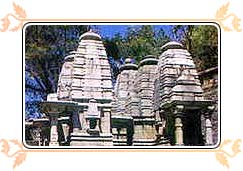Besides the main temple of Badrinath there are four other smaller badri temples. These are collectively called the panch badris or five badris. Very few pilgrims however, visit the other four Badri temples.
- Yogadhyan Badri (1920 m.)
Closest to the main temple of Badrinath lies this tiny, sleepy hamlet which remains unnoticed by most pilgrims and is the winter home for the idol at Badrinath. Pandukeshwar is also an important archaeological site. Some years ago, four ancient metal foils engraved with a description of several kings in the region were discovered here. Believed to be over 1500 years old, these foils are kept at Joshimath, 30 km downstream. - Bhavishya Badri (2,744 m.)
The bhavishya or future badri is situated at Subain near Tapovan, about 17 km east of Joshimath. According to Hindu belief, when evil is on the rise in this world, the two mountains Nara and Narayan at Badrinath will close up on each other and destroy the route to the present Badrinath. This would also mark the end of the present world and the beginning of a new one. Lord Badrinath will then appear at the Bhavishya Badri temple and be worshipped here instead of at the present one. - Bridha Badri or the 'Old Badri'
Bridha Badri or the 'old Badri' is the third temple about 7 kms short of Joshimath, on the main  Rishikesh-Badrinath motor road at Animath. It is believed that Badrinath was worshipped here before its enshrinement by Shankaracharya at the main Badrinath seat. The temple of Bridha Badri is open throughout the year. Rishikesh-Badrinath motor road at Animath. It is believed that Badrinath was worshipped here before its enshrinement by Shankaracharya at the main Badrinath seat. The temple of Bridha Badri is open throughout the year. - Adi Badri
Adi Badri is the farthest from the other four badris. It is approachable from Karnaprayag by a motorable road enroute Ranikhet. The temple complex has 16 small temples with intricate carvings.
Seven of these temples belong to the late Gupta period. Local tradition assigns these buildings to Shankaracharya. The main temple is distinguished by a pyramid shaped raised platform, with a black stone idol of Vishnu.
|
No comments:
Post a Comment